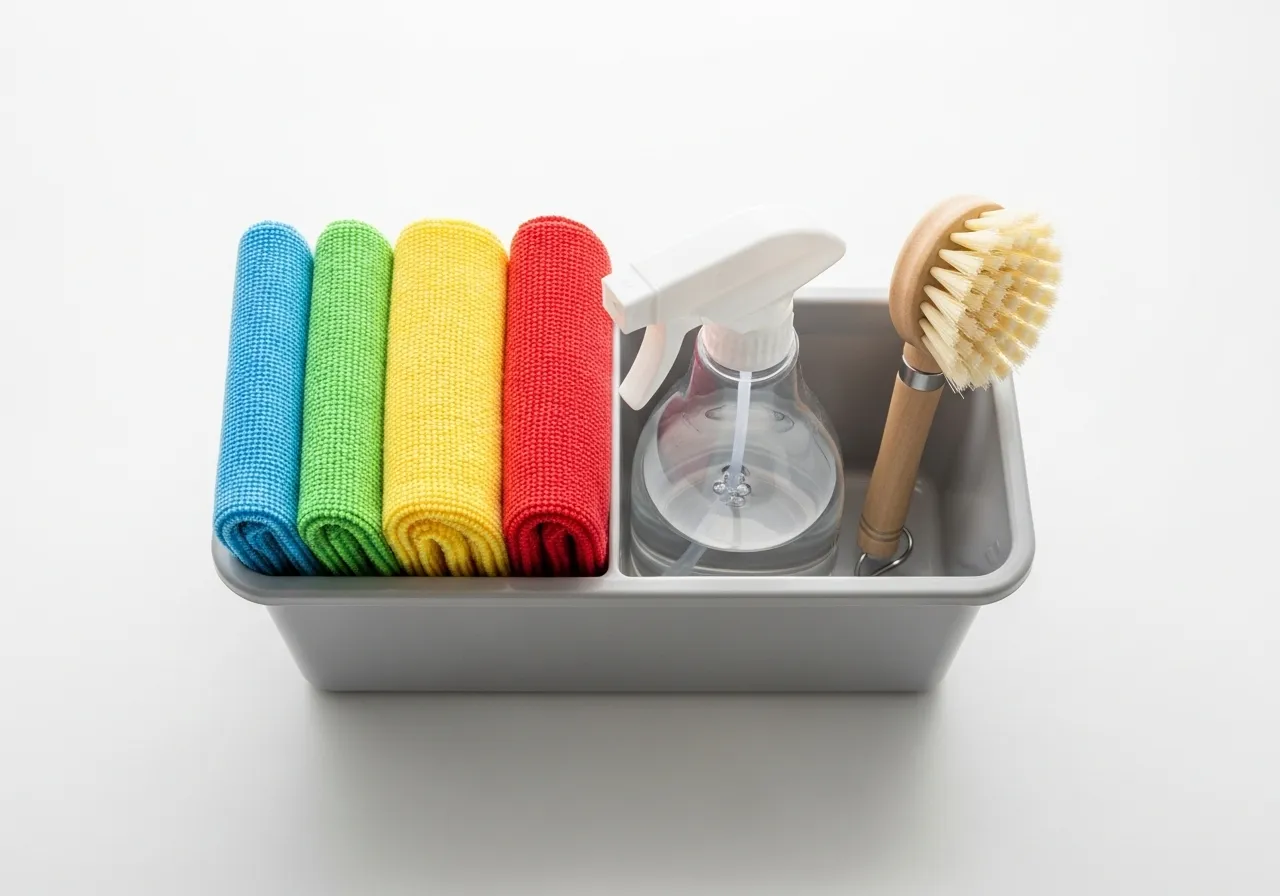
Your Essential Cleaning Toolkit: Simplicity and Safety First
You don’t need a closet overflowing with specialized products to keep your home clean. A few versatile, effective tools are all it takes. Focusing on simple supplies not only saves money and space but also reduces your exposure to harsh chemicals. Before we dive into the daily tasks, let’s assemble our toolkit.
Core Supplies for Everyday Tasks
Microfiber Cloths: These are the workhorses of a modern cleaning routine. They trap dust, dirt, and bacteria effectively with just water, reducing the need for chemical sprays. Have a color-coded system to prevent cross-contamination—for example, blue for glass, green for general surfaces, yellow for the kitchen, and red for the bathroom.
A Good All-Purpose Cleaner: You can buy a commercial pH-neutral cleaner, which is safe for most surfaces, or make your own. A simple solution of a few drops of mild dish soap in a spray bottle of warm water works wonders for countertops, cabinets, and more. A pH-neutral cleaner is one that is not strongly acidic or alkaline, making it gentle on materials.
Spray Bottles: Keep at least two: one for your all-purpose soap solution and one for a disinfecting solution (like a 1:1 mix of white vinegar and water, for appropriate surfaces). Make sure to label them clearly and add the date you mixed the solution.
A Squeegee: An inexpensive shower squeegee can be used after every shower to prevent soap scum and mildew buildup on glass doors and tile walls, saving you significant scrubbing time later.
A Vacuum and/or Broom: A lightweight vacuum, stick vacuum, or a simple broom and dustpan is essential for daily floor maintenance in high-traffic areas.
A Scrub Brush and an Old Toothbrush: For tackling grout, faucet bases, and other tight spots where grime builds up.
Simple, Safe DIY Cleaner Recipes
Many effective cleaners can be made from common household ingredients. They are economical and give you control over what you bring into your home.
All-Purpose Cleaner: In a 24-ounce spray bottle, mix 2 cups of warm water with 1 teaspoon of mild dish soap. Shake gently to combine. This is excellent for non-porous surfaces like laminate countertops, sealed wood, and linoleum.
Glass and Mirror Cleaner: In a spray bottle, combine 1 cup of distilled white vinegar and 1 cup of water. This 1:1 ratio cuts through smudges and leaves a streak-free shine. Important: Never use vinegar or any acidic cleaner on natural stone like marble, granite, or travertine, as it can etch and dull the surface. Also, avoid using it on unsealed grout or some hardwood floor finishes.
Gentle Scouring Paste: Mix baking soda with just enough water to form a thick paste. This is a fantastic, non-abrasive cleaner for scrubbing sinks, tubs, and even lifting certain stains from countertops. Apply the paste, let it sit for 5-10 minutes, then gently scrub and rinse thoroughly.
Critical Safety Rules: A Non-Negotiable Checklist
Safety should always be your top priority when cleaning. Please commit these rules to memory.
NEVER Mix Chemicals: This is the most important rule. Never, ever mix cleaning products, especially bleach and ammonia, which create toxic chloramine gas. Similarly, mixing bleach with an acid (like vinegar or some toilet bowl cleaners) creates chlorine gas. Mixing vinegar and hydrogen peroxide in the same container can create corrosive peracetic acid. Stick to one product at a time.
Ensure Good Ventilation: Always open a window or turn on an exhaust fan when cleaning, especially in enclosed spaces like bathrooms. This helps dissipate fumes and keeps the air fresh.
Protect Yourself: Wear rubber gloves to protect your skin from drying out or reacting to cleaning solutions. Consider safety glasses if you are cleaning overhead or splashing is a risk.
Read the Label: For any commercial product you use, read the manufacturer’s instructions and safety warnings first. The label will tell you which surfaces it’s safe for and what precautions to take.
Patch Test First: When using a new cleaner or trying one on a new surface, always test it in a small, hidden spot first—like behind an appliance or in a corner—to ensure it doesn’t cause damage or discoloration.
If you ever have questions about product safety, the U.S. Environmental Protection Agency (EPA) offers resources like its Safer Choice program. In case of an emergency, such as ingestion or severe skin reaction, contact Poison Control (U.S.) immediately.

















